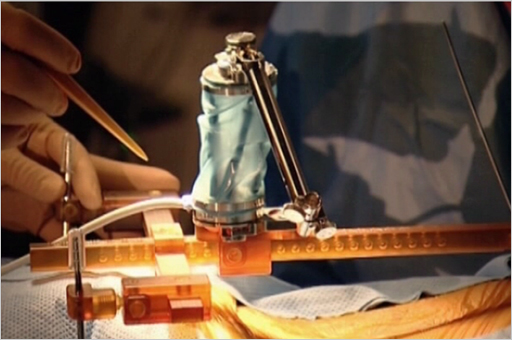|
|
 |
|
|
 |
|
|
 |
 |
| Ihr persönlicher Ansprechpartner |
| Gerne helfen wir Ihnen weiter! |
 |
 Sie erreichen uns unter: Sie erreichen uns unter:
+49 (0) 89 / 316 10 16 |
|
|
 |
 |
 |
 |
 |
 |
 |
 |
 |
Clinical Case Series With Post-Operative CT Analysis.Spine Surgery
With Miniature Robotic Guidance |
 |
 |
 Background
Background
Accurate and precise placement of pedicle screws is important yet challenging. Misplaced screws may result in neural and vascular injury, with short- and long-term sequelae.
Study Design
A prospective, multi-center, clinical case series analysis was done to examine clinical accuracy and efficacy of bone-mounted robotic guidance for spine surgery, based on post-operative CT analysis.
Methods
Twenty eight patients, average age fifty four (33-77). Indications for surgery included spinal instability, spondylolysis, spondylolisthesis, degenerative and inflammatory disc disease, joint disease and adjacent level disease;
Six of the patients were obese (class I, II and III), and four were revision cases. Surgical procedures included single level to three levels (T12 – S1) TLIF, PLIF and posterior fusion cases, including open and minimally-invasive techniques. Pedicle screws were introduced using miniature robotic guidance in all cases. The system utilized a pre-operative CT scan for optimal planning of screw size and position, two fluoroscopic images (AP and Oblique) for automatic registration to the CT data, and a rigid frame - attached to the bony anatomy percutaneously or via a small midline incision – as a basis for the miniature robotic device.
The device then guides the introduction of instrumentation to entry points and trajectories in accordance with the pre-operative plan.
Post-operative CT scans were obtained for all patients and screw placements were evaluated and divided into 4 categories:
- completely within the pedicle
- pedicle wall breach less than 2 mm
- pedicle wall breach 2–4 mm
- pedicle wall breach greater than 4 mm
Each screw was evaluated in the axial and lateral views independently.

Results
A total of 113 screws were implanted using the robotic system. 3 screws could not be evaluated due to poor post-operative CT quality. 108 (98.2%) of the 110 evaluated screws were in groups A+B (96+12, respectively). 2 screws (1.8%) were in group C and no screws were in group D; hence all of the screws (100%) were within the safe zone for pedicle screws. There were no clinical sequelae; none of the screws had to be revised.

Conclusion
Miniature Bone-mounted robotic guidance technology yielded accurate, safe and reproducible placements. These results compare very favorably with reported accuracy in the literature. The technology is useful, reliable and beneficial for spine surgery.

SpineAssist - Miniature Robotic Guidance for Spinal Surgery – Cadaveric Efficacy Study for Time, Accuracy and Radiation Exposure.
Lieberman I.H., Hardenbrook M., Wang J., Guyer R.D. and Khanna J.
Robotic assisted spinal surgery - from concept to clinical practice.Computer Aided Surgery, Vol. 12, No. 2, March 2007, pp. 105–115
Shoham, M., Lieberman, I. H., Benzel, E. C., Togawa, D., Zehavi, E., Zilberstein, B., Roffman, M., Bruskin, A., Fridlander, A., Joskowicz, L., Brink-Danan, S. and Knoller, N.
Bone-Mounted Miniature Robotic Guidance for Pedicle Screw and Translaminar Facet Screw Placement: Part I - Technical Development and a Test Case Result.Journal of Neurosurgery, Vol. 59, No. 3,
September 2006 - Lieberman I. H., Togawa D., Kayanja M. M., Reinhardt, M. K., Friedlander A., Knoller N. and Benzel E. C.
|
 |
 |
 |
 |
 |
 |
 |
 |
|